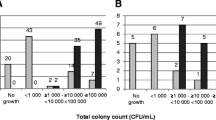Abstract
Midstream urine samples from 37 patients with urinary tract infections were studied by electron microscopy, hemagglutination, and the salt aggregation test (SAT) to measure the hydrophobicity of the bacterial surface.Escherichia coli subcultured from these urine samples were tested in the same way. Fimbriae were visualized onE. coli in the urine of 31 specimens, and all these urines containedE. coli that expressed pronounced surface hydrophobicity and aggregated in ammonium sulfate of 0.1–1.6 M final concentration. Hemagglutination of human and/or guinea pig erythrocytes was expressed by 21E. coli in the urine. TheE. coli strains subcultured from these 31 urine samples were also fimbriated, but the number of fimbriae per bacterium as well as the percentage of fimbriated bacteria varied compared with the directly collected strains. The surface hydrophobicity and hemagglutination were similar to the results with the directly collected bacteria. However, after serial transfer in CFA-broth under static conditions, all non-hemagglutinating strains expressed mannose-sensitive hemagglutination of guinea pig erythrocytes, and three strains also expressed weak mannose-resistant hemagglutination of human erythrocytes. Following serial transfer, fimbriae were also visualized on the sixE. coli strains that appeared non-fimbriate in the urine. It is thus concluded thatE. coli causing urinary tract infection are often fimbriated and express surface hydrophobicity in the urine. Based on these findings, a rapid method to isolate hydrophobic, possibly fimbriated bacteria was tried in which the urine was mixed with a hydrophobic gel. Hydrophobic bacteria bound to the gel and could be eluted from the sedimented gel.
Similar content being viewed by others
Literature Cited
Bar-Shavit, Z., Goldman, R., Ofek, I., Sharon, N., Mirelman, D. 1980. Mannose-binding activity ofEscherichia coli: a determinant of attachment and ingestion of the bacteria by macrophages. Infection and Immunity29:417–424.
Björkstén, B., Wadström, T. 1982. Interaction of fimbriatedEscherichia coli with polymorphonuclear leucocytes. Infection and Immunity,38:298–305.
Brinton, C. C., Jr. 1977. The piliation phase syndrome and the uses of purified pili in disease control, pp. 33–70. In: Proceedings of the 13th Joint Conference on Cholera. Department of Health, Education and Welfare Publication No 78-1590. Bethesda: National Institutes of Health.
Chick, S., Harber, M. J., Mackenzie, R., Asscher, A. W. 1981. Modified method for studying bacterial adhesion to isolated uroepithelial cells and uromucoid. Infection and Immunity34:256–261.
Duguid, J. P., Clegg, S., Wilson, M. I. 1979. The fimbrial and non-fimbrial haemagglutinins ofEscherichia coli. Journal of Medical Microbiology12:213–227.
Duguid, J. P., Old, D. C. 1980. Adhesive properties of Enterobacteriaceae, pp. 186–217. In: Beachey, E. H. (ed.) Bacterial adherence. Receptors and Recognition Series B, Volume 6. London: Chapman and Hall.
Evans, D. G., Evans, D. J., Jr, Tjoa, W. 1977. Hemagglutination of human group A erythrocytes by enterotoxigenicEscherichia coli isolated from adults with diarrhea: correlation with colonization factor. Infection and Immunity18:330–337.
Faris, A., Wadström, T., Freer, J. 1981. Hydrophobic, adsorptive and hemagglutinating properties ofEscherichia coli possessing colonization factor antigens (CFA/I or CFA/II), type 1 pili and other pili. Current Microbiology5:67–72.
Green, C. P., Thomas, V. L. 1981. Hemagglutination of human type O erythrocytes, hemolysin production and serogrouping ofEscherichia coli isolates from patients with acute pyelonephritis, cystitis and asymptomatic bacteriuria. Infection and Immunity31:309–315.
Hagberg, L., Jodal, U., Korhonen, T., Lindin-Jansson, G., Lindberg, U., Svanborg Edén, C. 1981. Adhesion, hemagglutination and virulence ofEscherichia coli causing urinary tract infections. Infection and Immunity31:564–570.
Harber, M. J., Chick, S., Mackenzie, R., Asscher, A. W. 1982. Lack of adherence ot epithelial cells by freshly isolated urinary pathogens. LancetI:586–588.
Kuch, B., Pál, T., Emödy, L. 1982. Bacterial adherence and urinary tract infection. LancetII:107.
Källenius, G., Möllby, R., Svensson, S. B., Winberg, J., Lundbald, A., Svensson, S., Cedergren, B. 1980. The Pk antigen as receptor for the hemagglutinin of pyelonephriticEscherichia coli. FEMS Microbiology Letters7:297–302.
Leffler, H., Svanborg-Edén, C. 1980. Chemical identification of a glycosphingolipid receptor forEscherichia coli attaching to urinary tract epithelial cells and agglutinating human erythrocytes. FEMS Microbiology Letters8:127–134.
Lindahl, M., Faris, A., Wadström, T., Hjertén, S. 1981. A new test based on “salting out” to measure relative surface hydrophobicity of bacterial cell. Biochimica Biophysica Acta677:471–476.
Ljungh, Å., Wadström, T. 1982. Salt aggregation test for measuring cell surface hydrophobicity of urinaryEscherichia coli. European Journal of Clinical Microbiology1:388–393.
Marrie, T. J., Lam, J., Costerton, J. W. 1980. Bacterial adhesion to uroepithelial cells: A morphological study. Journal of Infectious Diseases142:239–246.
Mäkelä, P. H., Korhonen, T. K. 1982. Bacterial adherence and urinary tract infection. LancetI:961.
Ofek, I., Mosek, A., Sharon, N. 1981. Mannose-specific adherence ofEscherichia coli freshly excreted in the urine of patients with urinary tract infections and of isolates subcultured from the infected urine. Infection and Immunity34:708–711.
Ørskov, I., Ferenc, A., Ørskov, F. 1980. Tamm-Horsfall protein or uromucoid is the normal urinary slime that traps type I fimbriatedEscherichia coli. LancetI:887.
Schwartz, J., Menoret, P., Begue, P., Lasfargues, G. 1982. Bacterial adherence and urinary tract infection. LancetII:108.
Sjoblad, R. D., Doetsch, R. N. 1982. Adsorption of polarly flagellated bacteria to surfaces. Current Microbiology7:191–194.
Svanborg-Edén, C., Hagberg, L., Hansson, L. Å., Lomberg, H., Ørskov, I., Ørskov, F. 1982. Bacterial adherence and urinary tract infection. LancetII:962.
Wadström, T., Trust, T. J. 1983. Bacterial lectins. Medical Microbiology, in press.
Väisänen, V., Elo, J., Tallgren, L. G., Siitonen, A., Mäkelä, P. H., Svanborg-Edén, C., Källenius, G., Svensson, S. B., Hultberg, H., Korhonen, T. 1981. Mannose-resistant haemagglutination and P antigen recognition are characteristic ofEscherichia coli causing primary pyelonephritis. LancetII:1366–1369.
Author information
Authors and Affiliations
Rights and permissions
About this article
Cite this article
Ljungh, Å., Wadström, T. Fimbriation ofEscherichia coli in urinary tract infections. Comparisons between bacteria in the urine and subcultured bacterial isolates. Current Microbiology 8, 263–268 (1983). https://doi.org/10.1007/BF01577725
Issue Date:
DOI: https://doi.org/10.1007/BF01577725




